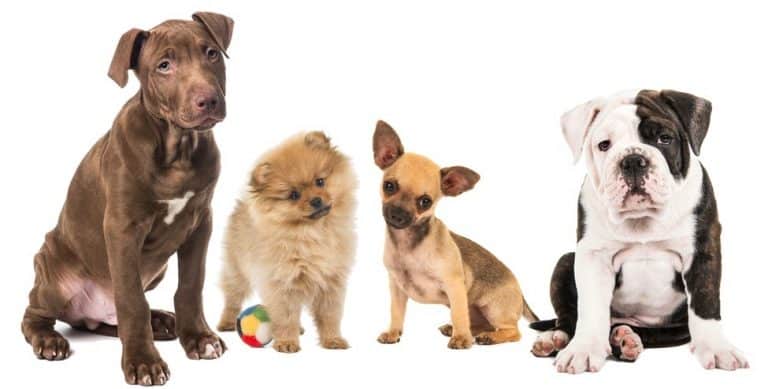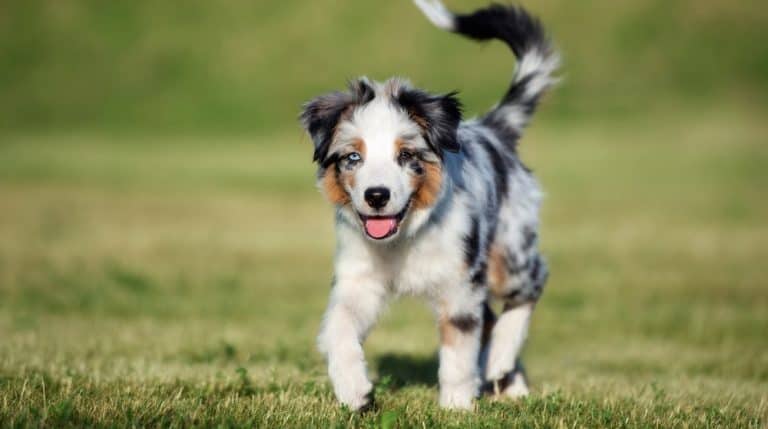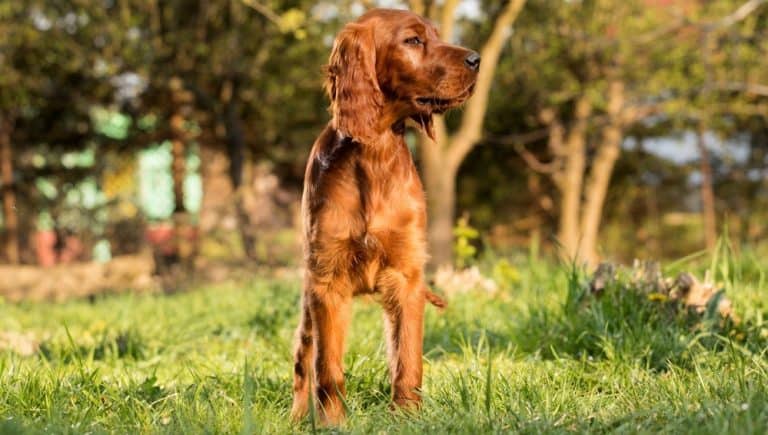English Mastiff Growth Chart – Mastiff Weight & Size Chart
It’s one of the oldest dog breeds out there, and one look at these beautiful big dogs with their impressive build and appealing faces will tell you a lot about why they’re still so popular.
Our English Mastiff growth chart should give you some indication, although the breed can be very variable!
Use it as a broad guideline, and consult your veterinarian if you’re concerned about your dog being under or overweight.
While other giant dog breeds may match their height, they’re record-breakers for their sheer weight and bulk. But how much should your English Mastiff weigh, other than “a lot?”
When Do English Mastiffs Stop Growing?
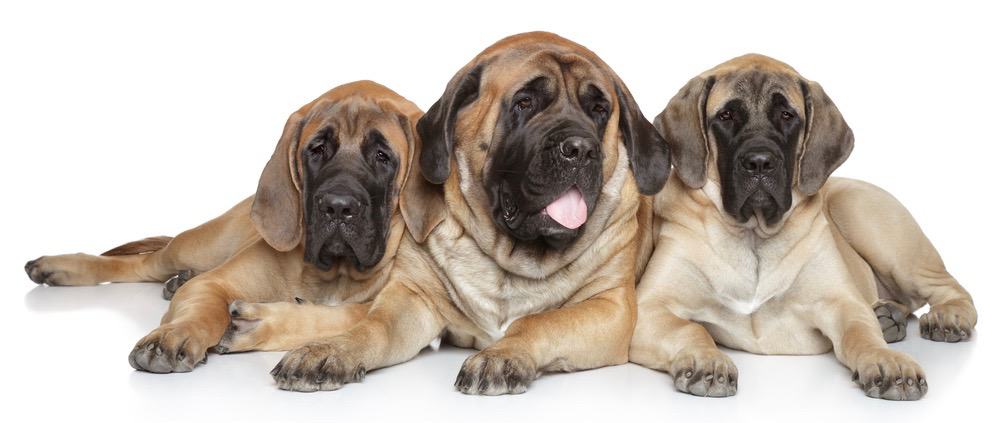
If you’re an experienced pet owner about to enjoy raising your first English Mastiff, the answer to the question “when do English Mastiffs stop growing?” may come as a surprise.
Mastiffs just keep on getting bigger, and although their growth tempo slows somewhat with the passage of time, you’re likely to see increases in weight and bulk that are part of their normal growth and development until the age of up to four or even five years.
That’s why our English Mastiff weight chart is considerably longer than it is for any other dog breed – we have a longer timeframe to track!
In a sense, we can say that English Mastiffs are puppies for longer than other dogs since regular dogs stop growing long before Mastiffs will.
English Mastiff Growth Chart
Compiling an English Mastiff size chart was no easy task. As we previously mentioned, this breed contains quite a lot of variability.
There are even those who say it’s not really possible to set expectations based on size and weight for this breed. You could have a “small” mastiff (it will still be huge) or a large one.
A look at your pup’s parents could provide some idea of what to expect from their offspring, but size, and therefore weight, can differ significantly, even between siblings from the same litter.
We’ve chosen averages to compile our weight chart, and most breeders agree that the information we’ve provided is about as accurate as you can get.
To use the weight chart, simply use your puppy’s age to find the relevant weights for male and female pups.
English Mastiff Weight Chart
| Age | Male Weight | Female Weight |
|---|---|---|
| 8 Weeks | 29.0 lbs | 24.0 lbs |
| 10 Weeks | 36.0 lbs | 32.0 lbs |
| 3 Months | 45.0 lbs | 39.0 lbs |
| 4 Months | 60.0 lbs | 50.0 lbs |
| 5 Months | 80.0 lbs | 65.0 lbs |
| 6 Months | 100 lbs | 80.0 lbs |
| 7 Months | 125 lbs | 90.0 lbs |
| 8 Months | 140 lbs | 100 lbs |
| 9 Months | 155 lbs | 110 lbs |
| 10 Months | 165 lbs | 112 lbs |
| 11 Months | 170 lbs | 115 lbs |
| 12 Months | 175 lbs | 120 lbs |
| 14 Months | 185 lbs | 125 lbs |
| 16 Months | 189 lbs | 125 lbs |
| 18 Months | 192 lbs | 127 lbs |
| 2 Years | 205 lbs | 135 lbs |
| 3 Years | 215 - 225 lbs | 155 -180 lbs |
| 4 Years | 220 - 230 lbs | 160 - 190 lbs |
| 5 Years | 220 - 235 lbs | 170 - 200 lbs |
If there’s a slight variance, there’s no need to fly into a panic – but do consult your veterinarian if you see substantial differences and are concerned about your pup’s health.
However, if your pup looks healthy and is behaving like a happy, bouncy youngster, it could just be a particularly large or small example of the breed which may mean adjusting the chart accordingly.
While your pup is still a youngster, it’s easy enough to use the bathroom scale for the weighing exercise – even if that means getting onto the scale with your pup in your arms.
Later on, that may be less feasible, but your veterinarian should have a suitable scale in his or her offices, and you can ask for a weigh-in at intervals.
English Mastiff Growth – What to Expect
No chart can include all the information you need to know if you’re hoping to use it to shape your expectations on things like your pup’s behavior.
So, as part of our English Mastiff growth chart exercise, we’ll also discuss the developmental aspects you’ll use to determine whether your puppy is developing normally.
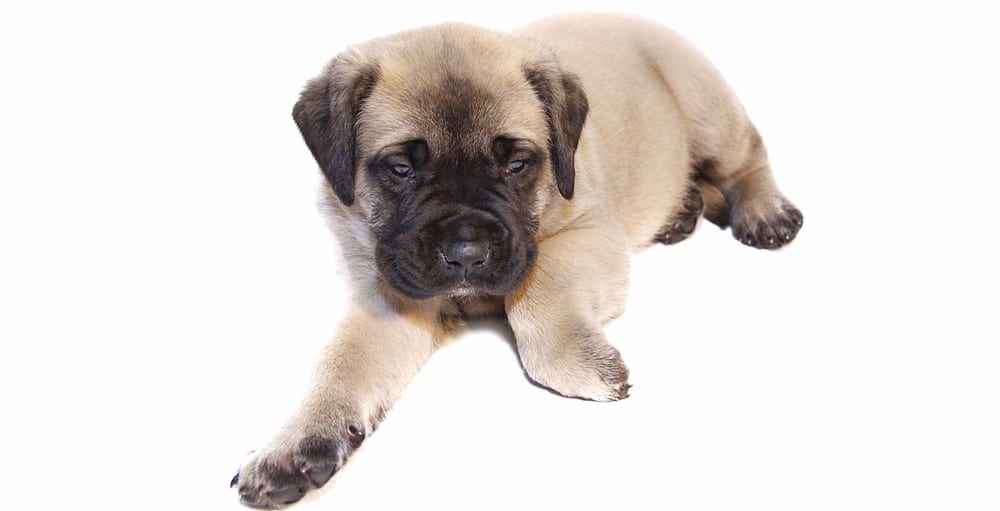
Birth to 2 Weeks
There’s not much for you to do at this stage. Newborn puppies are blind, deaf, and completely reliant on their mothers.
She’s the best and only one to care for them at this stage and the pup will do little else but sleep and squirm around to find a feeding site among suckling littermates.
Do pay extra special attention to Mom Mastiff – as you have hopefully been doing throughout her pregnancy. She will eat a lot, and you should expect her to eat up to three times the usual amount.
3 Weeks to 12 Weeks
At about two weeks old, the puppies; eyes begin to open, and they begin to hear sounds. However, their senses are still developing and they only see and hear properly at about four to five weeks of age.
As they receive input from the world around them, the English Mastiff pups become increasingly social with their mother, their littermates, and members of your family.
When they are between two and four weeks old, they also begin the weaning process, drinking less from their mom (who will ensure it by being less present as she is less needed) and being able to eat soft food or kibble softened with puppy formula. By eight weeks old, they should be fully weaned.
Socialization is important now. The pups will be ready to play and make friends and should be encouraged to do so.
Pups can be separated from their mothers at about eight weeks, but even before that, they can begin learning a few basics, such as not being too “mouthy” or biting. And at as young as 5 weeks, they can be housetrained if they are allowed to follow Mom outside to do their business.
4 Months to 6 Months
By now, English Mastiff pups should be in their “forever” homes and they’re growing so fast that it sometimes feels like you can see them getting bigger before your very eyes. They’re lively and full of fun and boundless energy.
Early training in the previous development phase will have included getting him used to a collar and leash, but don’t take young English Mastiff pups out for very long or strenuous walks just yet. Overtaxing them can lead to long-term problems.
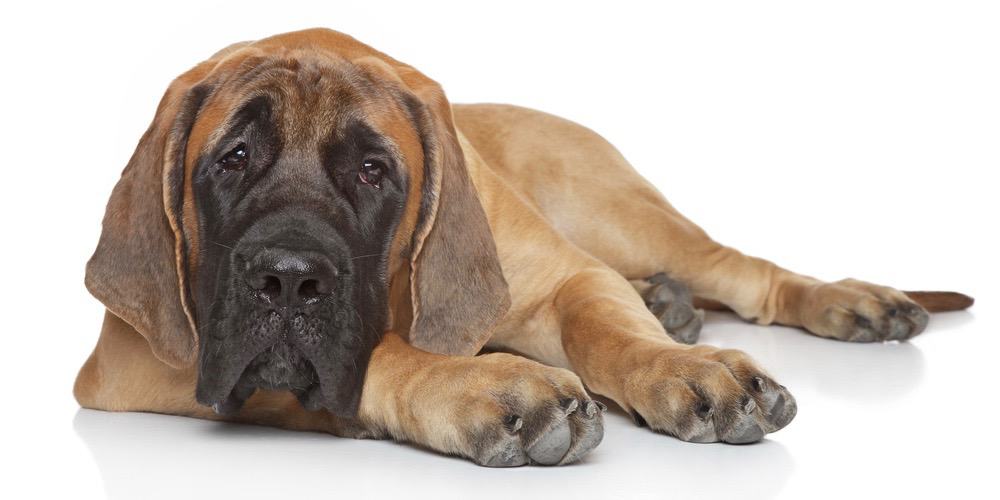
Since they’re learning as fast as they’re growing, it’s very important to ensure that they don’t pick up bad habits and to encourage good ones. Unless you’re very familiar with the business of raising and training a pup, classes for both of you will be a very good idea.
After all, behavior that you may be able to tolerate in a smaller dog will have a much greater impact in a larger one. Be patient and kind, but also be firm.
7 Months to 9 Months
By now your routines should be well established. Feeding times, walk times, and basic obedience will all be a matter of routine – although your adolescent pup will certainly try pushing his or her luck from time to time. From the time it is adopted, English Mastiffs will require human input and presence.
This is not the kind of dog you can leave locked up at home alone for extended periods as it will become bored. Bored dogs are often “naughty” and destructive, and in the case of a pup this big, the destruction will be spectacular!
10 to 12 months
By now, physical growth has slowed – but as previously noted, will continue for anything up to 5 years of age. Your pup is still just a youngster and will be playful and extremely energetic.
Those dog walks (preferably twice a day) will be as much of a blessing to you as it is to your pup since it will wear off at least some of the excess energy – but it’s still possible to overtax your baby giant. 
Use a rule of thumb of 5 minutes of walk time for every month of age to calculate the maximum amount of exercise your dog can enjoy every day.
Adult
As your dog grows into an adult, you will already have developed a good relationship in which your enormous dog and your family can coexist happily.
English Mastiffs have a mellow temperament and are very loyal and affectionate– but owing to their size, even quite gentle behavior can be a little overwhelming.
However, a well-trained youngster who gets plenty of attention and company will be a pleasant companion who loves nothing more than spending time with you.
How Big Do English Mastiffs Get?
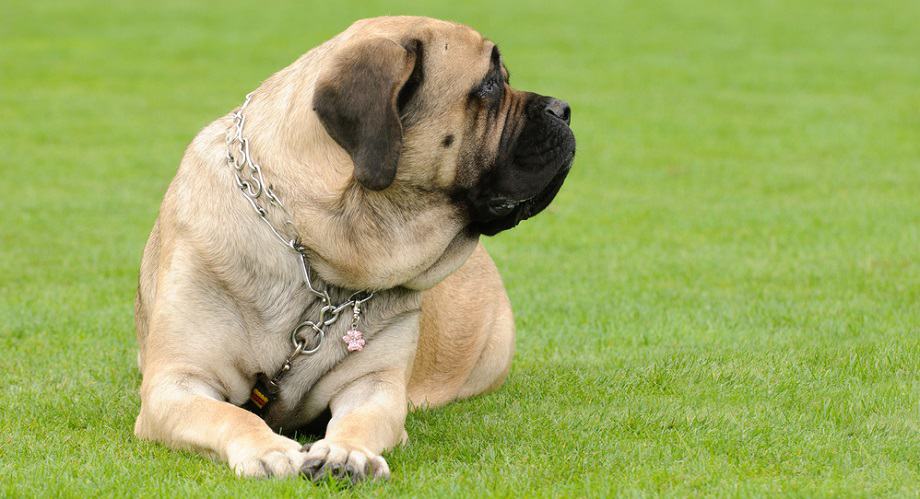
One of the best ways that you can figure out the future size of your English Mastiff would be to take a look at his parents.
By looking at his parents, you would get some idea about his final size. Usually, English Mastiffs grow to be the average size of both parents.
You can also look at his paws. Even though this is not foolproof, and the most accurate method, it can go a long way in telling you about your English Mastiff’s growth.
This is because dogs typically have larger faces and paws because they will eventually grow into them. So if you notice that your English Mastiff has a much larger paw than the rest of his body, then you know he still has more growing to do.
DNA tests are also an option that may be used to precisely pinpoint your dogs’ genealogy so that the proper calculations about his future size can be made. If all else fails, then you can simply look at the growth charts within this article.
Will Neutering/Spaying Affect My English Mastiff’s Growth?
For English Mastiffs your best bet would be to hold out until he reaches the age of one year and a half, or two years if you can.
This will allow your English Mastiff to have a better chance at a normal life since it will reduce his risk of life-threatening or degenerative disease. This also goes for breeding.
It is difficult for most owners to monitor the heat cycles of their dogs and notice the behavioral changes that come with it.
However, it is important to hold out as long as you can before spaying or neutering your English Mastiff. Your dog will be better off if you wait a bit longer.
However, spaying and neutering have their place because there are instances where it is needed and beneficial.
For example, with male dogs it can remove the likelihood of testicular cancer and also reduce the risk of other prostate disorders. For female English Mastiffs, there is the prevention of unwanted pregnancies as well as reducing the risk of urinary tract cancers.
English Mastiff Size Chart
English Mastiffs are large dogs, so you can imagine that they will have a tall height measurement. With dogs, generally, the height is taken by measuring from the ground, up to the withers. The withers are simply the highest point of your dog’s shoulder blades.
To measure your English Mastiff, simply drape the measuring tape from the ground up to the withers, after having him stand up straight.
When you are finished, you can take note of this measurement that you should be recording throughout his development.
Usually female English Mastiffs stand at a height of 27 to 32 inches tall while their male counterparts stand at 36 inches.
How To Properly Weigh And Measure An English Mastiff?

It is a good idea to measure your dog’s weight throughout his development. At a younger age, it is easier to do this. When your English Mastiff is at a young age, you can weigh him quite easily.
You simply need a little patience to keep him still while you place him on your bathroom scale. You can record this measurement and keep this information in a safe place.
However, when your English Mastiff is a grown-up and too large to fit on your bathroom scale, things start to get a bit tricky, but not impossible. To weigh your English Mastiff, you need to take a measurement of just your weight on a scale.
Next, you need to take a measurement of both you and your English Mastiff on that same scale. The difference between these two measurements will be the weight of your English Mastiff.
What Is A Mastiff’s Neck Size?
If you want to choose the right collar for your dog, then you need to have his neck size. Many people have collars that are too tight leading to discomfort and serious health problems.
This is also especially important as English Mastiffs have a lot of growing to do after starting off as small puppies.
On the flip side of that, are collars that are too slack and slip off your dog’s neck while you are walking them.
This can lead to serious issues because he could potentially run away or end up harming someone. This is the importance of having proper neck size measurements for your English Mastiff.
To measure your dog’s neck, all you need is a flexible measuring tape that you can drape around his neck.
Make it loose enough that two of your fingers can slide underneath the tape but no bigger than that. The measurement that you record is your dog’s neck size.
English Mastiff Body Condition Score (BCS)
The Body Condition Score or BCS is simply a BMI for pets. Human beings use the BMI to measure their body mass and the BCS can calculate the body fat of pets.
However, you can expect that the BCS will be a bit more complicated because of the variety of dog breeds that exist.
The body fat percentage can vary from breed to breed. For example, Whippet dogs are known to be much leaner than English Mastiffs. So it is difficult to use the same metric for optimal health across all dog breeds.
BCS calculations are able to standardize animal weights and can be used to recommend diet and exercise decisions for your English Mastiff. It primarily uses your dog’s silhouettes from aerial and profile positions.
It pays close attention to the ribs, waist, spine, muscle mass, abdomen, hip bones, and total fat covering.
How To Help Your English Mastiff Lose Weight If He Is Overweight
English Mastiffs can gain weight easily if they don’t have a proper diet and exercise. When your Mastiff has reached his senior years and is less active there need to be some adjustments in his diet.
If this is not done, there can be serious consequences when it comes to his health. Dogs that are overweight, tend to have a myriad of health problems that could be costly for owners and detrimental to dogs.
It’s pretty straightforward if you want to reduce the weight of your English Mastiff. The most important thing that you can do is to reduce his diet. Cut back on the calories and excess fat.
His diet should be more protein-dense and have fewer carbohydrates. If you are unable to find a kibble that is high in protein, then you can switch to a high protein diet that you prepare at home.
You also need to ensure that he has enough fiber in his diet so that he can have a healthy gut. You can get this fiber from fruits and vegetables that are safe for dogs to consume.
Many people do not know that dogs need fruits and vegetables as well.
Last but not least, you should engage your English Mastiff in exercise. If he is out of shape, then you should start off slowly and gradually increase the exercise intensity until his weight is reduced.
English Mastiff vs Tibetan Mastiff
There are several different types of Mastiff breeds, and you may be considering getting a Tibetan Mastiff instead of an English one.
While they are beautiful dogs, however, Tibetan Mastiffs are not recommended as a good choice for a family pet, while English Mastiffs definitely are!
Several countries have banned Tibetan Mastiff dog ownership, rating them as being too aggressive to keep as a pet. The problem is not their behavior around members of the family, but their overprotectiveness which can lead to tragedy.

Simply put, Tibetan Mastiffs are not sociable outside the family circle, whereas English Mastiffs are much gentler dogs. Which is larger? On average, English Mastiffs are the biggest!
Factors That Affect English Mastiff Puppy Growth
Genetics
Genetics determine the maximum size your English Mastiff puppy will grow to. However, genetics are complex, and just looking at mom and dad dog is only an indication of genetic potential.
It is possible that either parent may carry the genes of bigger or smaller forebears and that these, though not expressed in the parent, will find expression in the pup.
Genetic potential is just that. Several other factors can also contribute to a puppy not realizing its genetic legacy.
Nutrition
No matter what organism is under discussion, nutrition is one of the biggest factors that may affect whether it will realize the possibilities inherent in its genes. English Mastiffs are no different.
From the ability of the mother to suckle her young adequately, to the food it receives when it begins to eat solids, nutrition in the formative months of its development will be among the most significant factors in determining whether it will grow as strongly, as healthily, and as big as its genes say it can.
Physical Activity and Health
Ill health or injury are obvious stressors on the developing body of an English Mastiff pup. As with inadequate nutrition, poor health will lead to the pup not achieving its full potential.
Physical activity is important for muscle development, and with a large frame to support it, good muscle development is a must for the Mastiff. Make sure your puppy has ample space to play. This is not a dog breed suited to cramped living conditions.
How Long are English Mastiffs Pregnant?
Like other dogs, the average time for an English Mastiff pregnancy is around 63 days. It’s important to note that many English Mastiffs require C-Sections in order for both mom dog and babies to survive the ordeal.

The size of the puppies’ heads is among the factors that could spell trouble for both mom and pups. Be sure to have your pregnant English Mastiff checked out by a vet, and remember that C-Sections are more common in these dogs than natural birth. Leaving this one up to chance could cost you your best friend plus her entire litter of puppies!
How Many Puppies do English Mastiffs Have?
The average size of a litter of English Mastiff puppies is 8. But as with all things Mastiff, there are plenty of variations on the theme. It’s not unknown for a “litter” to consist of just one pup, while litters as large of 16, though rare, are possible.
Once again your visits to the veterinarian will help you to prepare for the imminent arrival of your new family of pups, determine the right feeding for the pregnant and lactating English Mastiff, and more. Choose a veterinarian who is ready to be supportive throughout.
You should also use the opportunity to discuss whether your dog will be safe if she has another litter, and decide whether you will have her sterilized. It may feel like a pity, but her health takes priority.
What if My English Mastiff is Not the Right Weight
As we have already mentioned, there are super small and gigantic mastiffs, and then, there are average-sized ones as represented in our English Mastiff weight chart.
The size of your dog indicates what its healthy weight should be, and you should expect weight gain as your dog bulks up in adulthood. If you’re still worried, assess your dog’s condition as objectively as you can.
You should be able to feel, but not see the ribs under the skin, and there should be a discernible waist.
If your dog is overweight, you may need to adjust feeding and exercise routines, and if underweight, despite eating the recommended amount for his or her size, a veterinary check-up is in order.
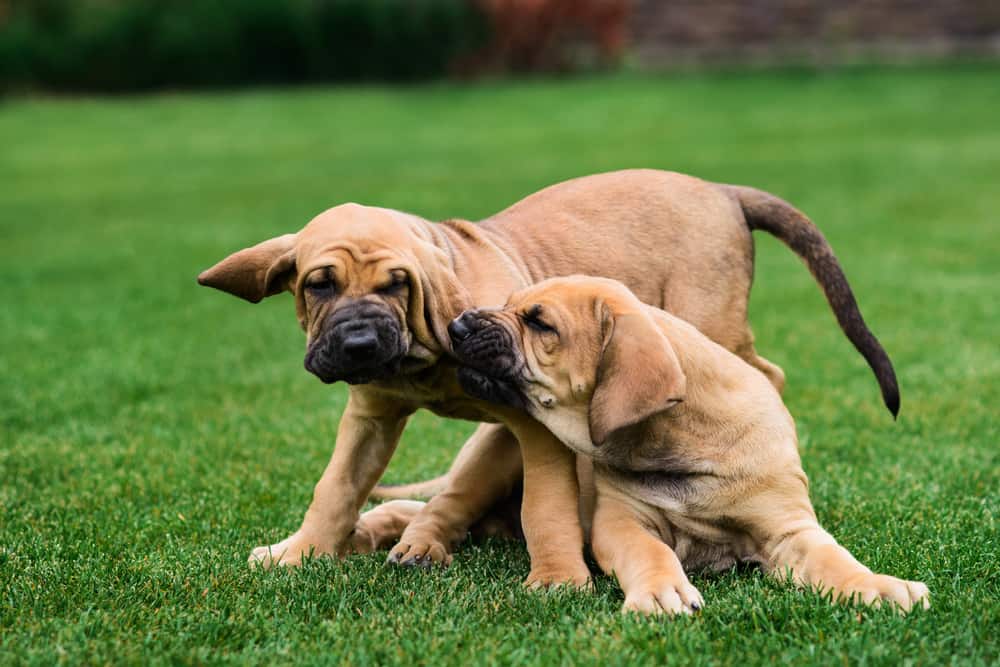
It’s possible that your dog has internal parasites and needs deworming, and if it has a poor appetite, something more sinister could be afoot.
While we’re talking about diet, do keep an eye on your dog’s stools. They’re a good indicator of digestive health and may indicate the need for a change in diet.
As for flatulence, it goes with the territory when it comes to mastiffs, but some dietary adjustments and supplements can reduce the problem or at least the odor!
What is the Life Expectancy of an English Mastiff?
If you’ve heard that giant breeds of dogs also have the shortest lifespan, it’s not just an urban legend. Unfortunately, gentle giants like the English Mastiff are not renowned for the length of their lifespans.
On average, 6 to 12 years is what you can expect, but there are also records of English Mastiffs reaching the respectable age of 15 with good genetics, good care, and a little bit of luck!
To get the longest possible time together with your canine friend, pay attention to providing a good quality diet, enjoy your exercise together, and ensure that vaccinations are timely. But, despite the best care, you may not be to blame if your pet only reaches the average lifespan.
How Much Does it Cost to Own an English Mastiff?
The cost of English Mastiff pups will vary depending on the breeder from whom you buy it.
You should certainly not expect to pay less than $1200 for a pup, and if the price is lower, you may be justified in wondering why. But the price of your puppy is just the beginning.
English Mastiffs are big eaters, and as a person who values your pet, you won’t be buying the cheapest dog food. Instead, you’ll choose a brand that offers high-quality nutrition, and with increasing quality, we also see higher prices.
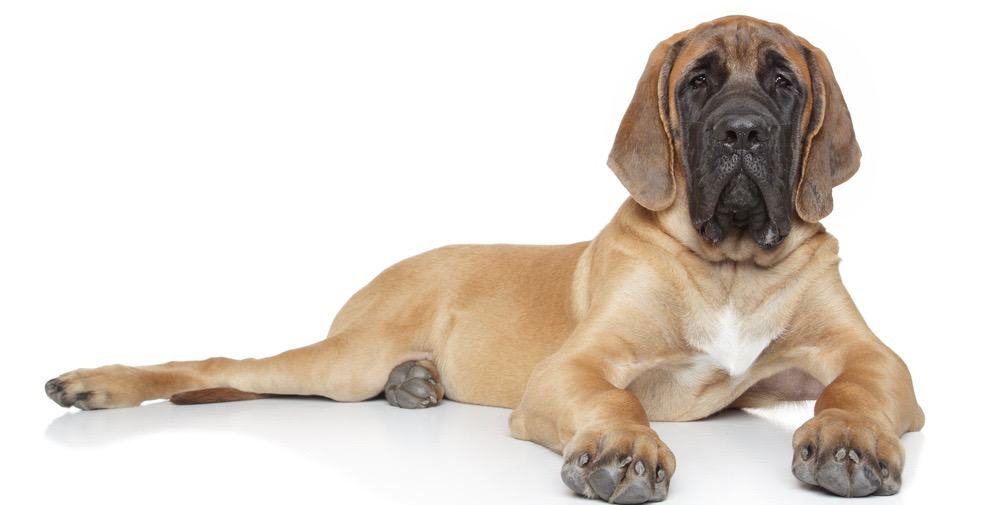
You should also consider the need for puppy and dog training classes that will help to keep your English mastiff obedient, and sociable towards other people and animals. With a dog this big, skimping on training could be disastrous for both of you.
Over and above that will be the regular veterinary costs for routine procedures like vaccinations as well as the potential need for treatments to address any illnesses or conditions that may develop over time.
English Mastiff Genetics and Common Health Problems
One of the important things to check out before choosing an English Mastiff puppy is the history of a genetic defect that causes hip dysplasia.
This painful ailment makes it highly unethical to breed dogs with genetics that may lead to the expression of hip dysplasia in the offspring. However, even when both parents have good genes, “throwback” genes can still be present.
Owing to their size and build, a variety of other health issues may lead to a shortened lifespan for an English Mastiff.
These include canine cancer, “bloat” or GDV, a condition in which the dog’s stomach twists, and heart problems. Osteoarthritis is also common in these rapidly growing, rapidly aging dogs.
Less serious, but nevertheless cause for concern are a variety of skin conditions that plague all dogs with skin folds, and a variety of eye conditions, including cataracts, may also occur.
Choose puppies with good lineage, provide support for their health in the form of a good diet and exercise, and keep an eye out for any signs of issues that may require veterinary help.


